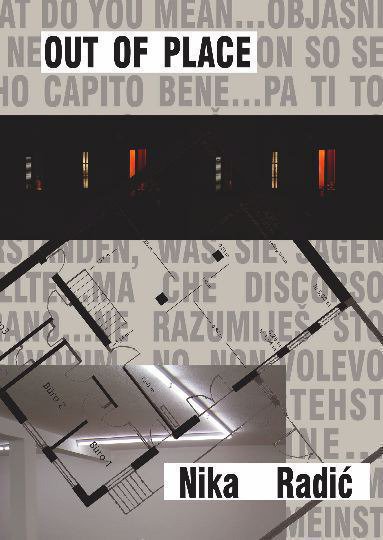Alexander Hick
Allan Sekula
Bernhard Rudiger
Chow Chun-Fai
Cyrill Lachauer
Denis Stepanovic
Fabian Hesse
Fabien Verschaere
Ingrid Wildi
Jean-Pierre Bertrand
Jordi Colomer
Matze Gorig
Pierre Coulibeuf
Robert Stadler
Ryuta Amae
Sammy Engramer
Stefan Nikolaev
Yuri Leiderman
9/9/2010
Nika Radic
Traversee, Munich
Out of Place. The artist tranfers the exhibition space into a fictive private apartment: There are pictures on the walls, a carpet on the floor, furniture and books. The visitor does not enter the typical white cube, he rather crosses a living space, which introduces a voyeuristic moment: as an observer inside an alien home, he is 'out of place'.

Artists: Alexander Hick - Allan Sekula - Bernhard Rüdiger - Chow Chun-Fai - Cyrill Lachauer - Denis Stepanovic - Fabian Hesse - Fabien Verschaere - Ingrid Wildi - Jean-Pierre Bertrand - Jordi Colomer - Matze Görig - Pierre Coulibeuf - Robert Stadler - Ryuta Amae - Sammy Engramer - Stefan Nikolaev - Yuri Leiderman
In our present, constantly networked surrounding, the own home remains one of our last private, intimate refuges, where we could let fall our masks and where we think we are protected from external glances. However, as Nika Radic reveals with Out of Place, our “holy home” is not absolutely safe from them.
The artist tranfers the exhibition space into a fictive private apartment: There are pictures on the walls, a carpet on the floor, furniture and books. The visitor does not enter the typical white cube, he rather crosses a living space, which introduces a voyeuristic moment: as an observer inside an alien home, he is “out of place”. And, no matter if deliberately or not, you cannot resist to have a look-around.
“What do you mean… ich hab’ nicht wirklich verstanden, was sie sagen wollte…” (trans.: I could not really understand what she wanted to tell): These sentences come from a short film of the artist (Party, 2007), where several party guests have a conversation in different languages. The snatches in Italian, German, English and Croatian refer to the impossibility of understanding each other. In the exhibition, this is visualized by a carpet with printed quotations.
Communication is the most important tie between two persons – our counterpart is permanently sending messages, verbally and non-verbally, that we are absorbing continuously. This is comparable to the perception of an art work: during the reception, something is triggering us, which either corresponds with the intention of the artist or maybe entirely contradicts it.
Also Nika Radic’s photographs on the gallery walls evoke associations, because they are not alien, they are tied in our common picture memory. The series Other People’s Windows was taken in each particular city, in which Nika Radic used to live or lives at the moment. The scenes are showing a gaze in the living rooms of the opposing neighborhood apartments and strange people, photographed from the window over the road. A few sequence pictures of two guys from Milan appear to be film stills and so, they get a narrative element. The viewer is tempted to project his own stories into these short extracts of someone else’s life and to fill the blanks and breaks with his own imagination – which parallels the situation of communication, too: We try to grasp the whole beyond the conversation itself.
As there are various levels of communication, e. g. body language, the exhibition space is also extended to an additional level by different video projections. Opened doors, partly projected, partly mounted on the wall, encourage the viewer to take a glance in another room. Compared to baroque painting, the element of the Trompe-l‘oeil provokes an illusion. Nevertheless, we cannot tell what really happens in another one’s life, but just develop an underlying context by only what we see.
One’s own identity is also formed by the own perception. Nika Radic showed in previous works, how subjective the own memory could be, while drawing floor plans of her old apartments from her memory. Her mother, architect Anela Djukan, drew construction drafts of the same places. By overlapping their both drawings, different memories of two single persons overlap and interfuse each other. For the exhibition Out of Place, Anela Djukan sketched a building plan for the architectural remodeling of the whole gallery building. As floor plans and sectional drawings, they become part of this fictive apartment and refer to a possible continuative remodeling of the exhibition space / fictive apartment, that is only provisional at the moment. - As we all know from our own experience, interim solutions remain sometimes the longest-lasting.
Nika Radic (born 1968 in Zagreb, Croatia) studied sculpture at the academy of fine arts in Zagreb and art history at the university in Vienna. In her video works and multimedia installations, she concentrates on the subjects of communication and voyeurism; moments, that everyone of us experiences very similarly, but still percepts and interprets in his own individual way. Nika Radic has participated in a number of solo- and group shows, amongst others at the Museum of Contemporary Art Vojvodina (Novi Sad, Serbia) and at Gallery Waldinger (Osijek, Croatia). Two of her latest video installations in the public space were Office Cleaning (Collegium Hungaricum, Berlin, 2008) and Tulum (on the occasion of the opening of the MSU Zabreb, 2010).
Anna Wondrak M.A. (Munich, July 2010)
Anna Wondrak studied art history, philosophy and Byzantine studies in Munich where she works as curator and art consultant since 2007.
Opening Friday, September 10th 2010, 6 to 9 pm
Traversée zeitgenössische Kunst e.K.
Dr. Judit Bönisch
Theresienstraße 56b, München
Hors: Tue-Fri 11-19, Sat 11-16
free admission



